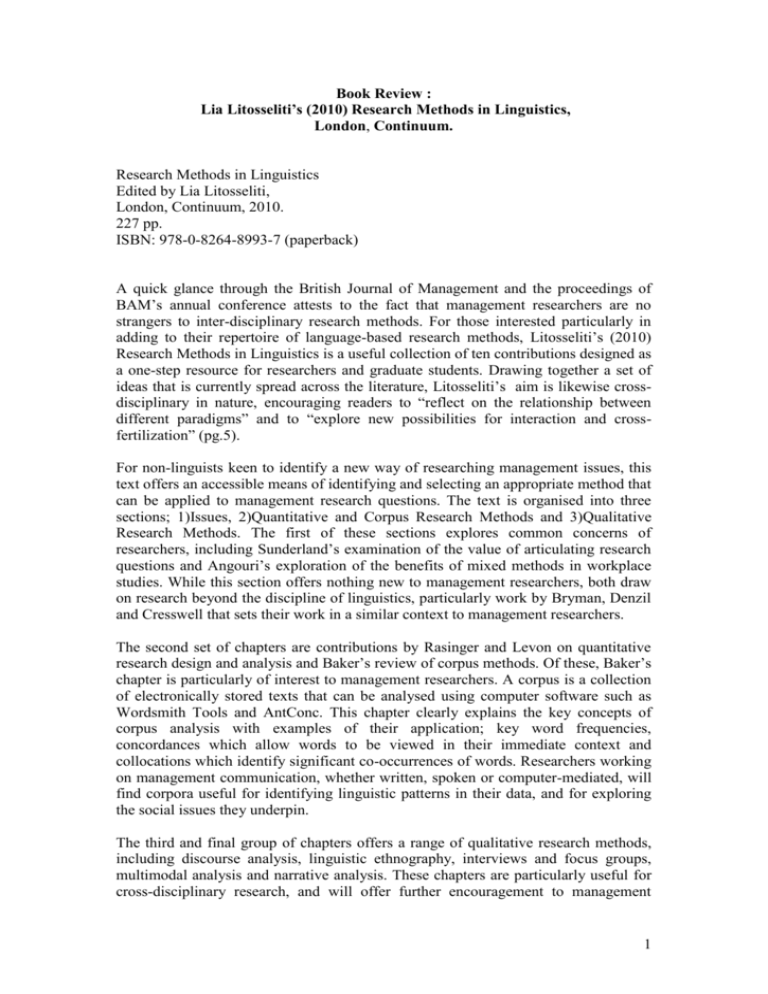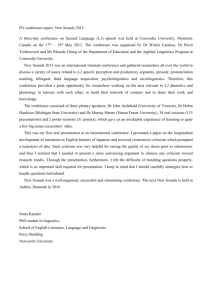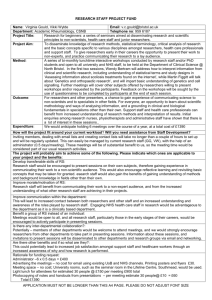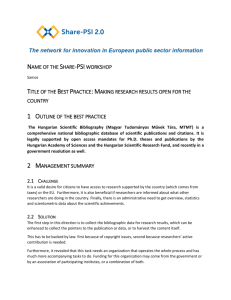Microsoft Word - UWE Research Repository
advertisement

Book Review : Lia Litosseliti’s (2010) Research Methods in Linguistics, London, Continuum. Research Methods in Linguistics Edited by Lia Litosseliti, London, Continuum, 2010. 227 pp. ISBN: 978-0-8264-8993-7 (paperback) A quick glance through the British Journal of Management and the proceedings of BAM’s annual conference attests to the fact that management researchers are no strangers to inter-disciplinary research methods. For those interested particularly in adding to their repertoire of language-based research methods, Litosseliti’s (2010) Research Methods in Linguistics is a useful collection of ten contributions designed as a one-step resource for researchers and graduate students. Drawing together a set of ideas that is currently spread across the literature, Litosseliti’s aim is likewise crossdisciplinary in nature, encouraging readers to “reflect on the relationship between different paradigms” and to “explore new possibilities for interaction and crossfertilization” (pg.5). For non-linguists keen to identify a new way of researching management issues, this text offers an accessible means of identifying and selecting an appropriate method that can be applied to management research questions. The text is organised into three sections; 1)Issues, 2)Quantitative and Corpus Research Methods and 3)Qualitative Research Methods. The first of these sections explores common concerns of researchers, including Sunderland’s examination of the value of articulating research questions and Angouri’s exploration of the benefits of mixed methods in workplace studies. While this section offers nothing new to management researchers, both draw on research beyond the discipline of linguistics, particularly work by Bryman, Denzil and Cresswell that sets their work in a similar context to management researchers. The second set of chapters are contributions by Rasinger and Levon on quantitative research design and analysis and Baker’s review of corpus methods. Of these, Baker’s chapter is particularly of interest to management researchers. A corpus is a collection of electronically stored texts that can be analysed using computer software such as Wordsmith Tools and AntConc. This chapter clearly explains the key concepts of corpus analysis with examples of their application; key word frequencies, concordances which allow words to be viewed in their immediate context and collocations which identify significant co-occurrences of words. Researchers working on management communication, whether written, spoken or computer-mediated, will find corpora useful for identifying linguistic patterns in their data, and for exploring the social issues they underpin. The third and final group of chapters offers a range of qualitative research methods, including discourse analysis, linguistic ethnography, interviews and focus groups, multimodal analysis and narrative analysis. These chapters are particularly useful for cross-disciplinary research, and will offer further encouragement to management 1 researchers already using language-based approaches such as narrative and discourse analysis. The term ‘discourse’ however has multiple uses and interpretations that can be the cause of confusion for newer researchers. In the first chapter of this section Baxter outlines the different uses of the term and reviews four key approaches to discourse analysis and the traditions from which they are derived; conversation analysis, discourse analysis, critical discourse analysis and feminist post-structuralist discourse analysis. Creese’s review of linguistic ethnography is an example of the combination of diverse research traditions, and is particularly suited to interdisciplinary research. Edley and Liosseliti’s chapter on interviews and focus groups provides a review of the arguments surrounding naturalistic and contrived data, and explores the constructivist view of interviewing methods. While this chapter provides a review of methods which are relatively under-utilised in linguistic research, it contains little that is new to management researchers already embedded in such methods. One of the strengths of the final two chapters, Bezemer and Jewitt’s review of key issues in Multimodal Analysis, and Gimenez’s chapter on narrative analysis, is that both provide step by step guidance to using the techniques. Multimodal analysis, an approach based on a social semiotic theory of communication, considers other meaning-making resources beyond language, including gaze, gesture and drawings. The chapter offers useful guidance on integrating accompanying video data into the analysis. Gimenez moves beyond traditional approaches which focus on the form and/or function of isolated narratives to offer a new framework for the critical analysis of narratives networks. Narrative networks, it is suggested, links narratives to the local and global social contexts in which they are produced and sheds light on the representational functions they serve in those contexts. In this collection of contributions, Litoselliti achieves her stated aim of presenting an ‘up-to-date one-stop resource for researchers and graduate students’(pg. 1). For researchers beyond the field of linguistics the text works as a demonstration of the portfolio of methods that can be adopted for researching management and organisational issues. While not always providing the detailed descriptions required for new researchers to employ these techniques, further readings are selected for each chapter. Language is central to researchers interested in exploring talk and interaction in organisations and markets, with some management researchers arguing that we need to take language more seriously in business and management research. As such, the language-based analytical methods covered in this text are likely to become increasingly valued in management research. Beverley Hill Lecturer in Management and Business Communication Winchester Business School University of Winchester March 2012 2





